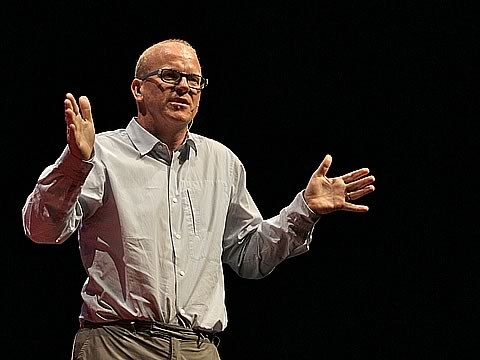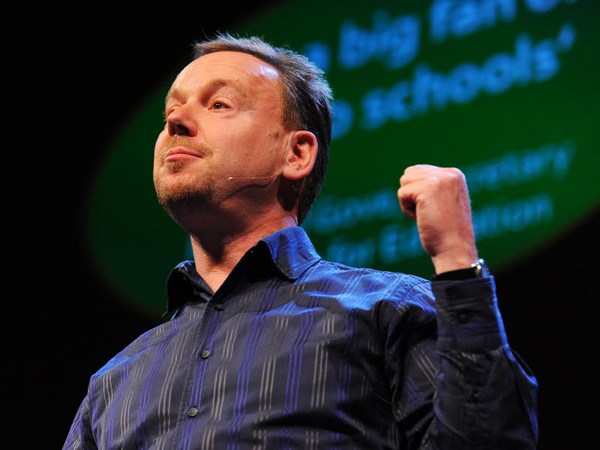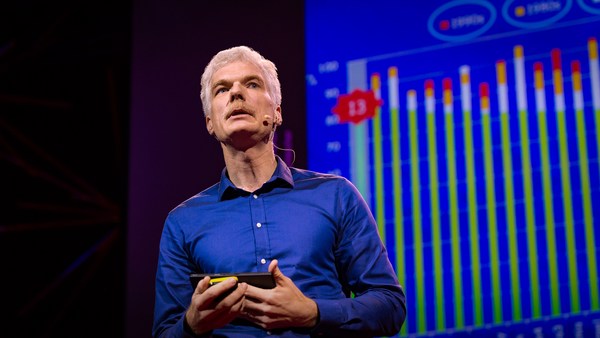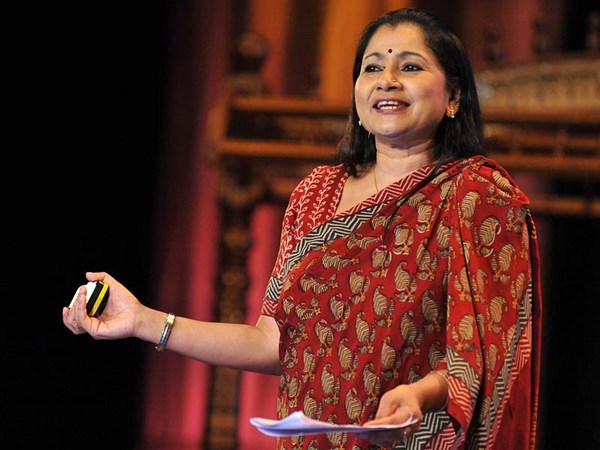It's a great pleasure to be here. It's a great pleasure to speak after Brian Cox from CERN. I think CERN is the home of the Large Hadron Collider. What ever happened to the Small Hadron Collider? Where is the Small Hadron Collider? Because the Small Hadron Collider once was the big thing. Now, the Small Hadron Collider is in a cupboard, overlooked and neglected. You know when the Large Hadron Collider started, and it didn't work, and people tried to work out why, it was the Small Hadron Collider team who sabotaged it because they were so jealous. The whole Hadron Collider family needs unlocking.
The lesson of Brian's presentation, in a way -- all those fantastic pictures -- is this really: that vantage point determines everything that you see. What Brian was saying was science has opened up successively different vantage points from which we can see ourselves, and that's why it's so valuable. So the vantage point you take determines virtually everything that you will see. The question that you will ask will determine much of the answer that you get.
And so if you ask this question: Where would you look to see the future of education? The answer that we've traditionally given to that is very straightforward, at least in the last 20 years: You go to Finland. Finland is the best place in the world to see school systems. The Finns may be a bit boring and depressive and there's a very high suicide rate, but by golly, they are qualified. And they have absolutely amazing education systems. So we all troop off to Finland, and we wonder at the social democratic miracle of Finland and its cultural homogeneity and all the rest of it, and then we struggle to imagine how we might bring lessons back.
Well, so, for this last year, with the help of Cisco who sponsored me, for some balmy reason, to do this, I've been looking somewhere else. Because actually radical innovation does sometimes come from the very best, but it often comes from places where you have huge need -- unmet, latent demand -- and not enough resources for traditional solutions to work -- traditional, high-cost solutions, which depend on professionals, which is what schools and hospitals are.
So I ended up in places like this. This is a place called Monkey Hill. It's one of the hundreds of favelas in Rio. Most of the population growth of the next 50 years will be in cities. We'll grow by six cities of 12 million people a year for the next 30 years. Almost all of that growth will be in the developed world. Almost all of that growth will be in places like Monkey Hill. This is where you'll find the fastest growing young populations of the world. So if you want recipes to work -- for virtually anything -- health, education, government politics and education -- you have to go to these places. And if you go to these places, you meet people like this.
This is a guy called Juanderson. At the age of 14, in common with many 14-year-olds in the Brazilian education system, he dropped out of school. It was boring. And Juanderson, instead, went into what provided kind of opportunity and hope in the place that he lived, which was the drugs trade. And by the age of 16, with rapid promotion, he was running the drugs trade in 10 favelas. He was turning over 200,000 dollars a week. He employed 200 people. He was going to be dead by the age of 25. And luckily, he met this guy, who is Rodrigo Baggio, the owner of the first laptop to ever appear in Brazil. 1994, Rodrigo started something called CDI, which took computers donated by corporations, put them into community centers in favelas and created places like this. What turned Juanderson around was technology for learning that made learning fun and accessible.
Or you can go to places like this. This is Kibera, which is the largest slum in East Africa. Millions of people living here, stretched over many kilometers. And there I met these two, Azra on the left, Maureen on the right. They just finished their Kenyan certificate of secondary education. That name should tell you that the Kenyan education system borrows almost everything from Britain, circa 1950, but has managed to make it even worse. So there are schools in slums like this. They're places like this. That's where Maureen went to school. They're private schools. There are no state schools in slums. And the education they got was pitiful. It was in places like this. This a school set up by some nuns in another slum called Nakuru. Half the children in this classroom have no parents because they've died through AIDS. The other half have one parent because the other parent has died through AIDS. So the challenges of education in this kind of place are not to learn the kings and queens of Kenya or Britain. They are to stay alive, to earn a living, to not become HIV positive. The one technology that spans rich and poor in places like this is not anything to do with industrial technology. It's not to do with electricity or water. It's the mobile phone. If you want to design from scratch virtually any service in Africa, you would start now with the mobile phone. Or you could go to places like this.
This is a place called the Madangiri Settlement Colony, which is a very developed slum about 25 minutes outside New Delhi, where I met these characters who showed me around for the day. The remarkable thing about these girls, and the sign of the kind of social revolution sweeping through the developing world is that these girls are not married. Ten years ago, they certainly would have been married. Now they're not married, and they want to go on to study further, to have a career. They've been brought up by mothers who are illiterate, who have never ever done homework. All across the developing world there are millions of parents -- tens, hundreds of millions -- who for the first time are with children doing homework and exams. And the reason they carry on studying is not because they went to a school like this. This is a private school. This is a fee-pay school. This is a good school. This is the best you can get in Hyderabad in Indian education. The reason they went on studying was this.
This is a computer installed in the entrance to their slum by a revolutionary social entrepreneur called Sugata Mitra who has conducted the most radical experiments, showing that children, in the right conditions, can learn on their own with the help of computers. Those girls have never touched Google. They know nothing about Wikipedia. Imagine what their lives would be like if you could get that to them.
So if you look, as I did, through this tour, and by looking at about a hundred case studies of different social entrepreneurs working in these very extreme conditions, look at the recipes that they come up with for learning, they look nothing like school. What do they look like? Well, education is a global religion. And education, plus technology, is a great source of hope. You can go to places like this.
This is a school three hours outside of Sao Paulo. Most of the children there have parents who are illiterate. Many of them don't have electricity at home. But they find it completely obvious to use computers, websites, make videos, so on and so forth. When you go to places like this what you see is that education in these settings works by pull, not push. Most of our education system is push. I was literally pushed to school. When you get to school, things are pushed at you: knowledge, exams, systems, timetables. If you want to attract people like Juanderson who could, for instance, buy guns, wear jewelry, ride motorbikes and get girls through the drugs trade, and you want to attract him into education, having a compulsory curriculum doesn't really make sense. That isn't really going to attract him. You need to pull him. And so education needs to work by pull, not push.
And so the idea of a curriculum is completely irrelevant in a setting like this. You need to start education from things that make a difference to them in their settings. What does that? Well, the key is motivation, and there are two aspects to it. One is to deliver extrinsic motivation, that education has a payoff. Our education systems all work on the principle that there is a payoff, but you have to wait quite a long time. That's too long if you're poor. Waiting 10 years for the payoff from education is too long when you need to meet daily needs, when you've got siblings to look after or a business to help with. So you need education to be relevant and help people to make a living there and then, often. And you also need to make it intrinsically interesting.
So time and again, I found people like this. This is an amazing guy, Sebastiao Rocha, in Belo Horizonte, in the third largest city in Brazil. He's invented more than 200 games to teach virtually any subject under the sun. In the schools and communities that Taio works in, the day always starts in a circle and always starts from a question. Imagine an education system that started from questions, not from knowledge to be imparted, or started from a game, not from a lesson, or started from the premise that you have to engage people first before you can possibly teach them. Our education systems, you do all that stuff afterward, if you're lucky, sport, drama, music. These things, they teach through. They attract people to learning because it's really a dance project or a circus project or, the best example of all -- El Sistema in Venezuela -- it's a music project. And so you attract people through that into learning, not adding that on after all the learning has been done and you've eaten your cognitive greens.
So El Sistema in Venezuela uses a violin as a technology of learning. Taio Rocha uses making soap as a technology of learning. And what you find when you go to these schemes is that they use people and places in incredibly creative ways. Masses of peer learning. How do you get learning to people when there are no teachers, when teachers won't come, when you can't afford them, and even if you do get teachers, what they teach isn't relevant to the communities that they serve? Well, you create your own teachers. You create peer-to-peer learning, or you create para-teachers, or you bring in specialist skills. But you find ways to get learning that's relevant to people through technology, people and places that are different.
So this is a school in a bus on a building site in Pune, the fastest growing city in Asia. Pune has 5,000 building sites. It has 30,000 children on those building sites. That's one city. Imagine that urban explosion that's going to take place across the developing world and how many thousands of children will spend their school years on building sites. Well, this is a very simple scheme to get the learning to them through a bus. And they all treat learning, not as some sort of academic, analytical activity, but as that's something that's productive, something you make, something that you can do, perhaps earn a living from.
So I met this character, Steven. He'd spent three years in Nairobi living on the streets because his parents had died of AIDS. And he was finally brought back into school, not by the offer of GCSEs, but by the offer of learning how to become a carpenter, a practical making skill. So the trendiest schools in the world, High Tech High and others, they espouse a philosophy of learning as productive activity. Here, there isn't really an option. Learning has to be productive in order for it to make sense.
And finally, they have a different model of scale, and it's a Chinese restaurant model of how to scale. And I learned it from this guy, who is an amazing character. He's probably the most remarkable social entrepreneur in education in the world. His name is Madhav Chavan, and he created something called Pratham. And Pratham runs preschool play groups for, now, 21 million children in India. It's the largest NGO in education in the world. And it also supports working-class kids going into Indian schools. He's a complete revolutionary. He's actually a trade union organizer by background, and that's how he learned the skills to build his organization.
When they got to a certain stage, Pratham got big enough to attract some pro bono support from McKinsey. McKinsey came along and looked at his model and said, "You know what you should do with this, Madhav? You should turn it into McDonald's. And what you do when you go to any new site is you kind of roll out a franchise. And it's the same wherever you go. It's reliable and people know exactly where they are. And there will be no mistakes." And Madhav said, "Why do we have to do it that way? Why can't we do it more like the Chinese restaurants?"
There are Chinese restaurants everywhere, but there is no Chinese restaurant chain. Yet, everyone knows what is a Chinese restaurant. They know what to expect, even though it'll be subtly different and the colors will be different and the name will be different. You know a Chinese restaurant when you see it. These people work with the Chinese restaurant model -- same principles, different applications and different settings -- not the McDonald's model. The McDonald's model scales. The Chinese restaurant model spreads.
So mass education started with social entrepreneurship in the 19th century. And that's desperately what we need again on a global scale. And what can we learn from all of that? Well, we can learn a lot because our education systems are failing desperately in many ways. They fail to reach the people they most need to serve. They often hit their target but miss the point. Improvement is increasingly difficult to organize; our faith in these systems, incredibly fraught. And this is just a very simple way of understanding what kind of innovation, what kind of different design we need.
There are two basic types of innovation. There's sustaining innovation, which will sustain an existing institution or an organization, and disruptive innovation that will break it apart, create some different way of doing it. There are formal settings -- schools, colleges, hospitals -- in which innovation can take place, and informal settings -- communities, families, social networks. Almost all our effort goes in this box, sustaining innovation in formal settings, getting a better version of the essentially Bismarckian school system that developed in the 19th century. And as I said, the trouble with this is that, in the developing world there just aren't teachers to make this model work. You'd need millions and millions of teachers in China, India, Nigeria and the rest of developing world to meet need. And in our system, we know that simply doing more of this won't eat into deep educational inequalities, especially in inner cities and former industrial areas.
So that's why we need three more kinds of innovation. We need more reinvention. And all around the world now you see more and more schools reinventing themselves. They're recognizably schools, but they look different. There are Big Picture schools in the U.S. and Australia. There are Kunskapsskolan schools in Sweden. Of 14 of them, only two of them are in schools. Most of them are in other buildings not designed as schools. There is an amazing school in Northen Queensland called Jaringan. And they all have the same kind of features: highly collaborative, very personalized, often pervasive technology, learning that starts from questions and problems and projects, not from knowledge and curriculum. So we certainly need more of that.
But because so many of the issues in education aren't just in school, they're in family and community, what you also need, definitely, is more on the right hand side. You need efforts to supplement schools. The most famous of these is Reggio Emilia in Italy, the family-based learning system to support and encourage people in schools. The most exciting is the Harlem Children's Zone, which over 10 years, led by Geoffrey Canada, has, through a mixture of schooling and family and community projects, attempted to transform not just education in schools, but the entire culture and aspiration of about 10,000 families in Harlem. We need more of that completely new and radical thinking. You can go to places an hour away, less, from this room, just down the road, which need that, which need radicalism of a kind that we haven't imagined.
And finally, you need transformational innovation that could imagine getting learning to people in completely new and different ways. So we are on the verge, 2015, of an amazing achievement, the schoolification of the world. Every child up to the age of 15 who wants a place in school will be able to have one in 2015. It's an amazing thing. But it is, unlike cars, which have developed so rapidly and orderly, actually the school system is recognizably an inheritance from the 19th century, from a Bismarkian model of German schooling that got taken up by English reformers, and often by religious missionaries, taken up in the United States as a force of social cohesion, and then in Japan and South Korea as they developed.
It's recognizably 19th century in its roots. And of course it's a huge achievement. And of course it will bring great things. It will bring skills and learning and reading. But it will also lay waste to imagination. It will lay waste to appetite. It will lay waste to social confidence. It will stratify society as much as it liberates it. And we are bequeathing to the developing world school systems that they will now spend a century trying to reform. That is why we need really radical thinking, and why radical thinking is now more possible and more needed than ever in how we learn.
Thank you. (Applause)





